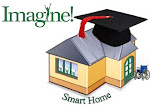The Institute created a summary of Greg’s presentation that you can find below, which is a very good representation of how technology can promote independence among individuals with developmental disabilities. Thanks for sharing!
PROMOTING INDEPENDENCE IN THE ENVIRONMENT
Gregory Wellems, Chief Operating Officer, Imagine!
Imagine!, which is a private not-for-profit organization in Colorado that provided support to 2,800 people in 2011, largely supports people on Medicaid who have relatively few assets. Imagine! therefore focuses on technology, since technology will be essential to overcome the barriers to care faced by those without extensive resources on which they can draw.
Providers tend to throw technology at problems, such as an online learning system, an online management system, an enterprise application, and a remote monitoring system. But unless these systems are tied together, they will not interrelate and work together. In addition, when smart homes or smart services are developed in universities, the people who test technologies tend to be college students pretending to have a disability, said Wellems. But the best way to develop technologies is to have people with cognitive and developmental disabilities use technologies to figure out what works and to determine where changes are needed.
Service providers need to have a strategic process to prioritize and analyze organizational “pain points.” For example, a six-inch binder full of paper is a pain point, because it is static information, whereas dynamic information is needed to plan for change. Technology produces change in services and caregiver dynamics, and organizations need to plan for such change.
Universal design has to encompass technology, Wellems observed. A house can have an outlet near the top of the door so that an automatic door opener can be added at some point. Ceilings can be reinforced to accommodate a barrier-free lift. Walls can be reinforced with particleboard or plywood so that a robotic arm can be added, and countertops can be adjusted up or down. Control panels can allow complete access to any outlet or device in the home so that doors or windows can be opened or closed and televisions and radios can be turned on or off. Energy use can be monitored to increase efficiency, and other kinds of dashboard systems can capture and analyze data and present that information in a meaningful way to an end user.
Imagine! uses a radio-frequency identification (RFID) system in its home to provide services to occupants as well as to inform caregivers and managers. The same system can be used to understand health care needs and how they change over time. For example, it can monitor the amount of time a caregiver spends with a client and how the amount changes over time. Remote monitoring systems can detect falls or proximity, provide for remote health monitoring, and compile other kinds of data. Cognitive support technology can work in any location, whether a home or the community.
Wellems pointed to a particular example of “low-hanging fruit” for promoting independence in the environment. The expertise of most corporations is in information technology, not in managing remote monitoring systems. Such expertise is increasing in some companies, but service providers are looking for more. For example, RFID technology needs to be more reliable to use with confidence in smart homes.
Wellems also cited the success of social media, which has redefined community for people with disabilities. Social media do not recognize disabilities, he said.
Finally, he emphasized the importance of personnel. A particular caregiver may understand a particular technology, but then a new caregiver arrives who does not. Service companies will need to do a better job of writing job descriptions, recruiting employees, and training them for their positions to provide support.
The goal is not just to create smart home after smart home, said Wellems. Families are waiting, and some individuals will not become eligible for Medicaid. Technologies need to be developed and widely implemented so that smart home concepts become familiar and common.



No comments:
Post a Comment